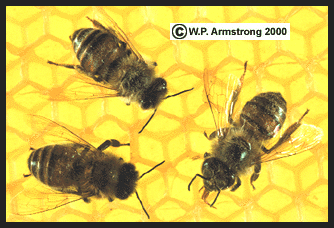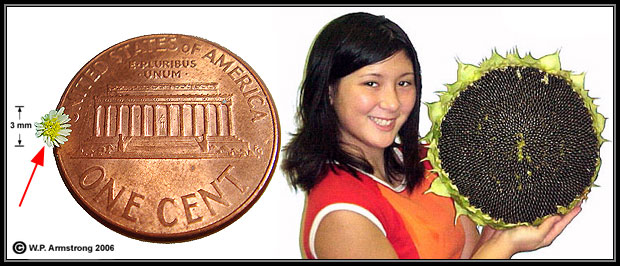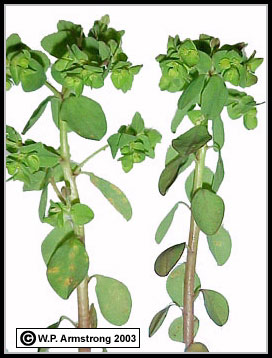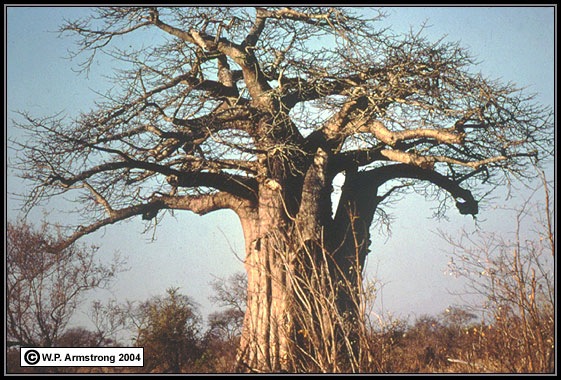|
Diversity Of Flowering Plants
The Continents And Islands Of The Earth
Some of the largest herbaceous (nonwoody) genera of flowering plants include sedges (Carex: 900), lupines (Lupinus: 300), asters (Aster: 600), onions (Allium: 500), rein orchids (Habenaria: 600), tree orchids (Dendrobium: 900), bulb-leaf orchids (Bulbophyllum: 1200), dancing-lady orchids (Oncidium: 500), indigo (Indigofera: 700), sorrel (Oxalis: 850), geranium (Geranium: 375), nightshade (Solanum: 1500), penstemon (Penstemon: 300), and the amazing locoweeds (Astragalus) with an estimated 2,000 species worldwide.
Some of the largest woody plant genera include Acacia (800), Eucalyptus (500), holly (Ilex: 440), Eugenia (600), heather (Erica: 530), passion fruit (Passiflora: 400), sage (Salvia: 500), rattan palm (Calamus: 340), Cassia (500), Croton (700), Prunus (200), Philodendron (250), Euphorbia (1600), and figs (Ficus: 1000). Not only are there at least 1,000 species of figs in the world, but they all have their own "in house" species of pollinator wasp.
All of these thousands of flowering plant species were given a scientific binomial by the botanists who named and described them. Scientific names are commonly derived from Greek or Latin and are spelled with the Roman alphabet the same way throughout the world. Therefore, Eschscholzia californica refers to California poppy, regardless of the country or native language. Scientific binomials consists of a first name or genus followed by a second name or specific epithet. These two names are similar to the given name and surname of humans. In addition, flowering plants often have one or more common (vernacular) names. Common names often commemorate a person, describe an interesting quality of the plant, or describe a location or habitat. These names are relatively easy to remember and pronounce. Sometimes the common names are very strange and make no sense at all. 
Some flowering plants do not have photosynthetic chlorophyll-bearing (green) leaves and are completely parasitic on the stems and roots of other plants. In order to grow and reproduce, they must absorb their vital carbohydrates (sugars) and amino acids from the host plant. Some of these root and stem parasites include the most bizarre plants on earth. Since they are nonphotosynthetic, they are also called heterotrophic like most animals and humans. Some heterotrophic plants look more like pale, fleshy fungi than flowering plants. They live in the deep humus of shady forests and include some very strange and colorful species. These "fungus flowers" are referred to as "mycotrophic" (fungus-nutrition) because their carbohydrates and amino acids come from mycorrhizal soil fungi which are in turn attached to the roots of nearby forest trees. Like true parasitic flowering plants, mycotrophic wildflowers must absorb their energy-rich molecules from other host plants, but unlike the direct root and stem parasites, their carbohydrates and amino acids are derived from nearby root systems via a conduit of filamentous soil fungi. Using labeled sugars containing radioactive carbon 14, scientists have shown that carbohydrates synthesized by nearby trees pass into the mycorrhizal soil fungi and eventually into the mycotrophic "fungus flowers."
But of all the marvelously adapted flowering plants, the carnivorous plants are truly the most amazing. Nitrogen is an essential element for all plants and animals because it is a key component of protein. It is abundant in the atmosphere and in the decaying organic matter of ponds and bogs where carnivorous plants commonly grow. However, the primary usable forms of nitrogen for plants are nitrates, produced from the decay of organic matter by the action of certain bacteria. Bogs containing carnivorous plants are often too acidic for the nitrate-forming bacteria. Herein lies the adaptive advantage of capturing insects as a supplemental source of usable nitrogen. The ingenious methods by which flowering plants are able to capture and digest small animals, such as insects and crustaceans, is absolutely remarkable.
Flowering plants represent an extraordinary diverse group of life forms. Although they all produce flowers and seed-bearing fruits, they come in an astonishing variety of shapes and sizes. Flowering plants range in size from minute wolffia plants (Wolffia globosa) less than a millimeter (1/25th of an inch) long to giant Australian eucalyptus trees (Eucalyptus regnans) over 300 feet (100 m) tall. Although the current record-holder for tallest tree is actually a 379 foot (116 m) conifer called the California redwood (Sequoia sempervirens), a fallen Eucalyptus regnans measuring 18 feet (5.4 m) in diameter and 435 feet (133 m) tall was reported from Australia in 1872. According to Stan Kelly (Eucalypts Volume 1, 1977), the tallest E. regnans currently standing is 322 feet (98 m). 
The common connecting link between all flowering plants is that they produce sexual reproductive organs called flowers. A flower is composed of 4 major parts: petals, sepals, stamens and one or more pistils (see above diagram). The number, shape, size, and arrangement of these floral parts varies considerably with different plant families, and is reflected in the tremendous diversity of flowering plants. According to the foremost authority on angiosperm diversity and phylogeny Dr. R.F. Thorne (The Botanical Review Volume 58: 225-348, 1992), the total number of different flowering plant families is 437. This great number of families is subdivided into 400 subfamilies, 12,650 genera and 233,885 species. For example: The grass family (Poaceae) has 3 stamens and one pistil, but no petals or sepals. The duckweed family (Lemnaceae) has one stamen and one pistil, and no petals or sepals. The cactus family (Cactaceae) has numerous stamens, one pistil, and numerous petals and sepals. The buttercup family (Ranunculaceae) has many stamens, many pistils, many petals and many sepals. Families with many separate floral parts (such as the Magnoliaceae and Ranunculaceae) are considered more primitive. Families with fewer floral parts which are fused together and irregularly shaped (such as the Orchidaceae) are considered more advanced in the evolution of flowering plants. Flowers without colorful petals and sepals are typically wind-pollinated and do not need showy parts to attract insects. Colorful, insect-pollinated flowers also produce sweet (sugary), fragrant nectar in nectar glands at the base of the blossom, which further entices insects to visit them.
One of the largest genera of flowering plants is Euphorbia with approximately 2,000 species. This enormous genus belongs to the very diverse euphorbia family (Euphorbiaceae). The variation within this genus is astonishing, from low-growing garden weeds called spurges to giant, cactus-like succulents that rival in size our North American sahuaro and organ-pipe cacti. South African euphorbias have evolved succulent, spine-covered stems that greatly resemble North American cacti, a biological phenomenon known as convergent evolution. It is difficult to believe that all these diverse forms belong to the same genus as the showy garden euphorbia called poinsettia (E. pulcherrima) until you carefully examine the blossom. The showy, red, modified leaves of poincettia are not petals. In fact, they are not even part of the true flowers. They surround clusters of small, greenish, cup-shaped structures called cyathia. Each cyathium is actually a flower cluster or inflorescence containing unisexual, apetalous male and female flowers. The inconspicuous male flowers occur in clusters and are reduced to a single red stamen, while the female flower consists of a single ovary (pistil) on a stalk (pedicel). In poinsettia the ovary is hidden within the cyathium, but in other species the ovary protrudes out of the cyathium at maturity. The rim of the cyathium also bears one-several, greenish nectar glands that are attractive to insect pollinators. In some species the glands are subtended by petal-like bracts (petaloid appendages). Poinsettias typically have only one greenish gland per cyathium and no petaloid appendages. This flower plan is quite different from the typical floral diagram above, but it is the basic theme in virtually all members of the amazing genus Euphorbia. It should be noted here that some authorities place the prostrate, herbaceous euphorbias (called spurges) with C-4 photosynthesis in the genus Chamaesyce.


Many members of the euphorbia family, including the genus Euphorbia, contain a poisonous milky-latex sap. The toxin is a mixture of diterpene esters, and contact with the skin may cause inflammation and a blistering rash. An Australian company called Peplin Biotech is conducting research on the sap of E. peplus as a simple topical treatment for certain skin cancers, such as basal cell carcinomas and squamous cell carcinomas. These are the most common human cancers, particularly in people who spend a lot of time outdoors in direct sunlight. For years, people in Australia have used the milky sap of E. peplus to cure cancerous spots on their skin. The fresh sap from E. peplus is applied directly to the cancerous spot. After a few days the area develops into an enlarged, swollen sore, followed by a scab that eventually dries and falls off. According to Peplin Biotech, the sap penetrates the skin and destroys the malignant tissue. This is essentially what happens when a dermatologist applies liquid nitrogen directly to a superficial cancerous growth on the skin. Whether this remarkable discovery is ever patented remains to be seen.
The duckweed family (Lemnaceae) includes the undisputed smallest and fastest reproducing flowering plants in the world. In fact, the genus Wolffia is Mr. Wolffia's (the editor of WAYNE'S WORD) favorite plant group. Imagine flowering wolffia plants (genus Wolffia) that weigh only 150 micrograms (1/190,000 of an ounce), or the approximate weight of two ordinary grains of table salt. Individual wolffia plants are 165,000 times shorter than the tallest Australian eucalyptus tree and 7 trillion times lighter than the most massive giant sequoia tree. They are carried from pond to pond on the feet of water fowl (tucked neatly under the ducks' bodies during flight), and there are records of wolffia plant bodies being carried by a tornado. They have even been reported in the water of melted hailstones. One wolffia plant is small enough to slip through the eye of an ordinary sewing needle, and at least 5,000 plants could be packed into a thimble. Each plant produces a microscopic flower inside a small cavity that develops on the upper side of the plant body. The minute flower consists of a single pistil and stamen. A bouquet of one dozen plants in full bloom will easily fit on the head of a pin. After pollination the ovary develops into a tiny one-seeded fruit called a utricle, which also holds the record for the world's smallest fruit.

Most of the botanical records listed in Botanical Record-Breakers (WAYNE'S WORD Volume 6 Spring 1997) belong to the amazing flowering plants. In fact, most of the plant articles featured in WAYNE'S WORD and Noteworthy Plants are angiosperms. Flowering plant records include the:
Although they may not be the most massive and tallest, flowering plants are certainly close rivals for these records with the African baobab (Adansonia digitata), Indian banyan (Ficus bengalensis) and the magnificent Australian Eucalyptus regnans. In fact, one large baobab can store 25,000 gallons of water weighing 100 tons, and a large Indian banyan has a documented spreading crown covering 4 acres and is supported by 1000 pillar-like prop roots. Alexander the Great reportedly camped with an army of 7,000 soldiers under such a fig tree.
Other WAYNE'S WORD and Noteworthy Plants articles about amazing and little-known flowering plants include the following:
In order for flowering plants to produce seeds, it is necessary for the flowers to be pollinated. Pollen grains must be transferred from the "male" anthers to the receptive "female" stigma. This can be accomplished on the same plant (self pollination) or may involve two different plants (cross pollination). The agents of pollination can be wind, water, insects, birds, and mammals (rodents, marsupials & bats); although insects are probably responsible for the pollination of most species. Flowers can be unisexual (with either male or female organs) or bisexual (with male stamens and female pistils). Flowering plant species can have separate male and female flowers on the same plant (monoecious) or separate male and female individuals within the population (dioecious). Individual flowers can be only a few millimeters across in Wolffia species (World's Smallest Flower), or they can be 3 feet (0.9 m) across in Rafflesia arnoldii (World's Largest Flower). The variation in flowers is absolutely staggering, and is reflected in the hundreds of different plant families distributed throughout the world.
Insect pollinated flowers typically have colorful petals, sweet nectar produced in nectar glands, and fragrant aromas; however, this is not always the rule. Some insect flowers emit the putrid aroma of rotting flesh and are appropriately called "carrion flowers." They attract the same insects that visit rotting carcasses to lay their eggs, such as flesh flies, blow flies and various beetles. In this case, the insects are tricked because the flower supplies no rotting flesh for the developing larvae to feed on. Carrion flowers occur in many different and unrelated plant families, including the milkweed family (Asclepiadaceae), arum family (Araceae) and the rafflesia family (Rafflesiaceae). They incluse some of the most bizarre bloosoms on earth, inclusing the world's largest flower (Rafflesia arnoldii).
About 90 percent of all flowering plants have bisexual flowers with both male (stamen) and female (pistil) sex organs. The remaining 10 percent have unisexual male and female flowers on the same plant (monoecious species) or male and female flowers on separate plants (dioecious species). To insure cross pollination, bisexual flowers may be protogynous (female stigma is receptive before pollen-bearing anther is mature), or protandrous (male anthers release pollen before female stigma is receptive). In these species, pollination is typically accomplished by different plants within the population which have pollen-bearing anthers or receptive stigmas in the correct stage of maturation. Actually plant sex is a lot more complicated than this, and botanists have come up with all sorts of terms to explain the different patterns of sexuality in flowering plant species: gynodioecious: Having bisexual flowers on one plant and female flowers on another. [e.g. Ficus carica, with "male" caprifigs and "female" edible figs.] androdioecious: Having bisexual flowers on one plant and male flowers on another plant. [e.g. Solanum, including certain species of nightshades.] polygamous: Having bisexual and unisexual flowers on the same plant. Not to be confused with human polygamy, or having two or more wives or husbands at the same time. Note: Sometimes the unisexual flowers may contain the rudimentary parts of the opposite sex. [e.g. Toxicodendron diversilobum, better known as poison oak.]
To really appreciate the role of insects in the pollination of flowers, consider the pollination of red clover (Trifolium pratense) by the European honey bee (Apis mellifera). According to D.J. Borror and D.M. DeLong (An Introduction To The Study Of Insects, 1964), one acre of red clover contains up to 216 million individual flowers, and every one of these must be visited by an insect before it will produce seed. In Ohio, 82 percent of the red clover population are pollinated by honey bees, and the remaining 15 percent are pollinated by bumble bees. The average seed yields of red clover are about 1-1.6 bushels per acre. With a dense honey bee population in the clover fields, the yield is increased to 8 bushels per acre, and with maximum insect pollination 12 to 20 bushels per acre. In some fruit orchards without honey bees, fruit set occurs in less than one percent of the blossoms. With honey bees, fruit set is increased to 44 percent of the blossoms. This is one of the reasons bee hives are placed in orchards. If the European honey bee colonies are taken over by the Africanized ("killer bee") strain, the consequences to Agriculture could be disastrous, especially if the bees must be exterminated because they are attacking people. In dollars and cents, the roll of honey bees as pollinators is enormous. For example, the average annual crop of clover seed in Ohio (250,000 bushels) will plant approximately 3 million acres in clover. This acreage would yield about 4.5 million tons of hay (worth about $90 million). Because of nitrogen fixation in the root nodules of clover, about 273 million pounds of nitrogen would be added to the soil (worth about $50 million).
Worker honey bees build elaborate wax honeycombs of hexagonal cells. The cells are used to store honey and for the developing bee larvae. Foraging bees drink flower nectar, filling their special stomachs where the nectar is converted into honey. Upon returning to the hive the sweet fluid (called bee vomit) is regurgitated into the wax cells. If the average distance traveled by a honey bee on a single nectar collecting trip is one mile, one pound of honey represents about 20,000 bee miles. The United States produces about 500 million pounds of honey per year representing 10 trillion honey bee miles. This distance is roughly equivalent to 50,000 round trips to the sun, or 20 million round trips to the moon.

The most complex and truly extraordinary method of insect pollination occurs in the genus Ficus (figs). Male and female fig wasps are borne inside hollow, fleshy, flower-bearing structures called syconia. [The syconium is what most people associate with the tasty fruit of a fig, but technically it is not a true fruit.] The syconium is lined on the inside with hundreds of tiny, pollen-bearing male flowers and seed-bearing female flowers, and the wasps develop from eggs laid inside the ovaries of the short-style female flowers (one egg per flower). In about half of the fig species (referred to as monoecious), male flowers and the long and short-style female flowers occur in the same bisexual syconium; but in all other fig species (referred to as dioecious or gynodioecious), the seed-producing, long-style female flowers only occur in unisexual syconia on female trees (with no male flowers). Since wasp eggs are not laid in the long-style flowers, the ovary of this type of flower contains a seed rather than a wasp (assuming it is pollinated). This remarkable floral dimorphism is how the fig tree produces seeds while still maintaining its vital, "in-house" population of symbiotic wasps. There are approximately 1,000 species of figs, mostly distributed throughout tropical regions of the world, and they all have their own pollinator wasp species that only enters their syconia through a small opening (called an ostiole) to pollinate the female flowers inside. [Some fig species may have two species of symbiotic wasp pollinators.] Without their special symbiotic wasps transferring pollen from one syconium to another, the female flowers inside would not get pollinated and no seeds would be produced (a catastrophe for the fig tree).
|








